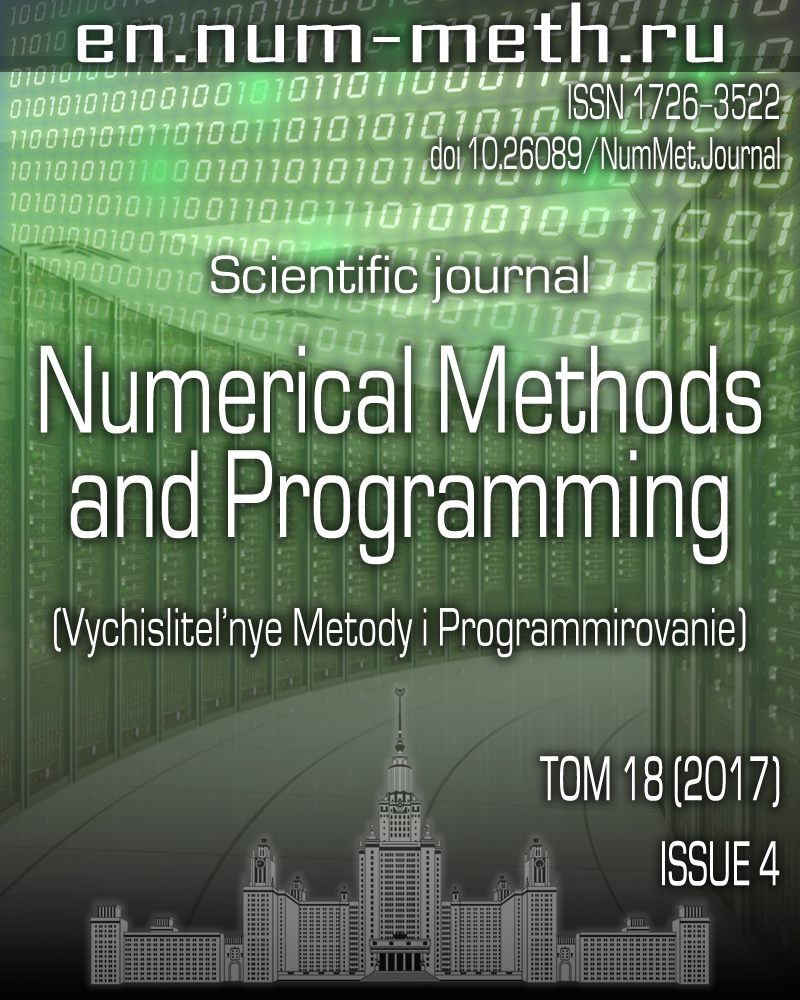DOI: https://doi.org/10.26089/NumMet.v18r429
Specific features of mathematical modeling of flows with detonation waves on unstructured computational grids
Keywords:
mathematical modeling
detonation wave
unstructured grids with triangular computational cells
detonation cell
Abstract
A mathematical model and a numerical algorithm for the mathematical modeling of two-dimensional flows with detonation waves on fully unstructured computational grids with triangular cells are proposed. The problem concerning the formation of cellular detonation in a plane channel in the case of stable detonation for different grid resolutions and with the use of first and second order schemes is considered.
Published
2017-08-30
Issue
Section
Section 1. Numerical methods and applications
References
- S. Taki and T. Fujiwara, “Numerical Analysis of Two-Dimensional Nonsteady Detonations,” AIAA J. 16 (1), 73-77 (1978).
- V. V. Markov, “Numerical Simulation of the Formation of a Multifrontal Detonation-Wave Structure,” Dokl. Akad. Nauk SSSR 258 (2), 314-317 (1981) [Sov. Phys. Dokl. 26 (2), 503-506 (1981)].
- A. J. Higgins, “Approaching Detonation Dynamics as an Ensemble of Interacting Waves,” in Proc. 25th Int. Conf. on the Dynamics of Explosions and Reactive Systems (ICDERS), Leeds, UK, August 2-7, 2015 , Paper PL3.
- I. Semenov, P. Utkin, and I. Akhmedyanov, “Mathematical Modeling of Detonation Initiation via Flow Cumulation Effects,” in Progress in Propulsion Physics , Vol. 8, pp. 389-406 (2016).
doi 10.1051/eucass/201608389 - I. V. Semenov, P. S. Utkin, and V. V. Markov, “Numerical Modeling of Two-Dimensional Flows with Detonation Waves Using High Performance Computing,” Vychisl. Metody Programm. 9, 119-128 (2008).
- V. A. Levin, I. S. Manuilovich, and V. V. Markov, “Initiation and Propagation of Multidimensional Detonation Waves,” Fiz. Goreniya Vzryva 51 (1), 47-56 (2015) [Combust., Expl., Shock Waves 51 (1), 36-44 (2015)].
- A. V. Dubrovskii, V. S. Ivanov, A. E. Zangiev, and S. M. Frolov, “Three-Dimensional Numerical Simulation of the Characteristics of a Ramjet Power Plant with a Continuous-Detonation Combustor in Supersonic Flight,” Khim. Fiz. 35 (6), 49-63 (2016) [Russ. J. Phys. Chem. B 10 (3), 469-482 (2016)].
- C. Hu and C.-W. Shu, “Weighted Essentially Non-Oscillatory Schemes on Triangular Meshes,” J. Comput. Phys. 150 (1), 97-127 (1999).
- L.F. Figueira da Silva, J. L. F. Azevedo, and H. Korzenowski, “Unstructured Adaptive Grid Flow Simulations of Inert and Reactive Gas Mixtures,” J. Comput. Phys. 160 (2), 522-540 (2000).
- F. Togashi, R. Löhner, and N. Tsuboi, “Numerical Simulation of H2/Air Detonation Using Unstructured Mesh,” Shock Waves 19 (2), 151-162 (2009).
- H. Shen and M. Parsani, “The Role of Multidimensional Instabilities in Direct Initiation of Gaseous Detonations in Free Space,” J. Fluid Mech. 813 (2017).
doi 10.1017/jfm.2017.5 - A. I. Lopato and P. S. Utkin, “Mathematical Modeling of Pulsating Detonation Wave Using ENO-Schemes of Different Approximation Orders,” Komput. Issled. Model. 6 (5), 643-653 (2014).
- J. J. Erpenbeck, “Stability of Steady-State Equilibrium Detonations,” Phys. Fluids 5 (5), 604-614 (1962).
- J. H. S. Lee, The Detonation Phenomenon (Cambridge University Press, Cambridge, 2008).
- R. Semenko, L. M. Faria, A. R. Kasimov, and B. S. Ermolaev, “Set-Valued Solutions for Non-Ideal Detonation,” Shock Waves 26 (2), 141-160 (2016).
- A. R. Kasimov and D. S. Stewart, “On the Dynamics of Self-Sustained One-Dimensional Detonations: A Numerical Study in the Shock-Attached Frame,” Phys. Fluids 16 (10), 3566-3578 (2004).
- A. I. Lopato and P. S. Utkin, “Detailed Simulation of the Pulsating Detonation Wave in the Shock-Attached Frame,” Zh. Vychisl. Mat. Mat. Fiz. 56 (5), 856-868 (2016) [Comput. Math. Math. Phys. 56 (5), 841-853 (2019)].
- E. F. Toro, Riemann Solvers and Numerical Methods for Fluid Dynamics: A Practical Introduction (Springer, Berlin, 2009).
- M.-S. Liou and C. J. Steffen, “A New Flux Splitting Scheme,” J. Comput. Phys. 107 (1), 23-39 (1993).
- G. Chen, H. Tang, and P. Zhang, “Second-Order Accurate Godunov Scheme for Multicomponent Flows on Moving Triangular Meshes,” J. Sci. Comput. 34 (1), 64-86 (2008).
- A. G. Kulikovskii, N. V. Pogorelov, and A. Yu. Semenov, Mathematical Aspects of Numerical Solution of Hyperbolic Systems (Fizmatlit, Moscow, 2001; CRC Press, Boca Raton, 2001).
- B. van Leer, “Towards the Ultimate Conservative Difference Schemes, V. A Second-Order Sequel to Godunov’s Method,” J. Comput. Phys. 32, 101-136 (1979).
- C.-W. Shu and S. Osher, “Efficient Implementation of Essentially Non-Oscillatory Shock-Capturing Schemes,” J. Comput. Phys. 77 (2), 439-471 (1988).
- D. J. Mavriplis, Solution of the Two-Dimensional Euler Equations on Unstructured Triangular Meshes , PhD Thesis (Princeton Univ., Princeton, 1987).
- Y. Mahmoudi and K. Mazaheri, “High Resolution Numerical Simulation of the Structure of 2-D Gaseous Detonations,” Proc. Combust. Inst. 33 (2), 2187-2194 (2011).
- V. V. Mitrofanov, Detonation of Homogeneous and Heterogeneous Systems (Lavrentyev Inst. Hydrodynamics, Novosibirsk, 2003) [in Russian].
- VisIt.
https://wci.llnl.gov/simulation/computer-codes/visit/. Cited October 6, 2017. - V. N. Gamezo, D. Desbordes, and E. S. Oran, “Two-Dimensional Reactive Flow Dynamics in Cellular Detonation Waves,” Shock Waves 9 (1), 11-17 (1999).
License
Copyright (c) 2017 Вычислительные методы и программирование

This work is licensed under a Creative Commons Attribution 4.0 International License.


